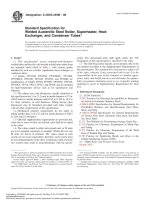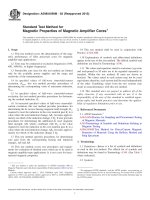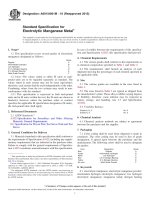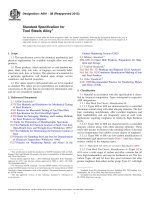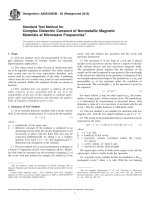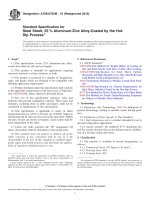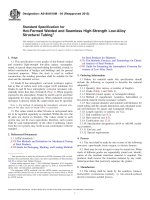Astm a 917 08 (2015)
Bạn đang xem bản rút gọn của tài liệu. Xem và tải ngay bản đầy đủ của tài liệu tại đây (85.19 KB, 3 trang )
Designation: A917 − 08 (Reapproved 2015)
Standard Specification for
Steel Sheet, Coated by the Electrolytic Process for
Applications Requiring Designation of the Coating Mass on
Each Surface (General Requirements)1
This standard is issued under the fixed designation A917; the number immediately following the designation indicates the year of
original adoption or, in the case of revision, the year of last revision. A number in parentheses indicates the year of last reapproval. A
superscript epsilon (´) indicates an editorial change since the last revision or reapproval.
Iron and Steel Articles with Zinc or Zinc-Alloy Coatings
A370 Test Methods and Definitions for Mechanical Testing
of Steel Products
A754/A754M Test Method for Coating Weight (Mass) of
Metallic Coatings on Steel by X-Ray Fluorescence
A879/A879M Specification for Steel Sheet, Zinc Coated by
the Electrolytic Process for Applications Requiring Designation of the Coating Mass on Each Surface
A902 Terminology Relating to Metallic Coated Steel Products
A918 Specification for Steel Sheet, Zinc-Nickel Alloy
Coated by the Electrolytic Process for Applications Requiring Designation of the Coating Mass on Each Surface
A1008/A1008M Specification for Steel, Sheet, Cold-Rolled,
Carbon, Structural, High-Strength Low-Alloy, HighStrength Low-Alloy with Improved Formability, Solution
Hardened, and Bake Hardenable
A1011/A1011M Specification for Steel, Sheet and Strip,
Hot-Rolled, Carbon, Structural, High-Strength LowAlloy, High-Strength Low-Alloy with Improved
Formability, and Ultra-High Strength
B504 Test Method for Measurement of Thickness of Metallic Coatings by the Coulometric Method
1. Scope
1.1 This specification covers hot-rolled and cold-rolled steel
sheet coated by the electrolytic process. Coatings can be
comprised of pure metals or metal alloys. For specific coatings,
refer to Specifications A879/A879M and A918.
1.2 The product shall be coated on one or both surfaces with
equal or differential coating masses on the two surfaces.
Sheet-coated with equal coating masses on each surface has
similar levels of corrosion protection on each surface. Often,
however, a higher level of corrosion protection is required on
one surface than is required on the other. In these situations,
one surface shall be specified with a heavier coating mass than
the other. Either surface, when specified to be painted, will
provide additional corrosion protection as compared to an
unpainted surface.
1.3 This coating process has essentially no effect on the base
metal mechanical properties, and use is permitted on any grade
of hot-rolled or cold-rolled steel sheet. The coated sheet is
available as Commercial Steel (CS), Drawing Steel (DS), Deep
Drawing Steel (DDS), Extra-Deep Drawing Steel (EDDS),
Structural Steel (SS) High-Strength Low-Alloy Steel
(HSLAS), High-Strength Low-Alloy Steel with Improved
Formability (HSLAS-F), Solution-Hardened Steel (SHS), or
Bake-Hardenable Steel (BHS).
3. Terminology
1.4 The values stated in SI units are to be regarded as the
standard.
3.1 Definitions— For definitions of terms and abbreviations
used in this specification, see Terminology A902.
2. Referenced Documents
4. Ordering Information
4.1 Ordering information for all products is shown in the
individual product specifications.
2
2.1 ASTM Standards:
A90/A90M Test Method for Weight [Mass] of Coating on
5. Coating Designation (Mass and Type)
5.1 The following seven-character format shall be used to
identify the coating mass required:
5.1.1 First and Second Characters —Minimum coating
mass of the surface with the less critical surface quality
requirements;
5.1.2 Third Character— A letter, as designated in the
appropriate product specification, to denote the kind of coating;
G for pure zinc and N for zinc-nickel alloy;
1
This specification is under the jurisdiction of ASTM Committee A05 on
Metallic-Coated Iron and Steel Products and is the direct responsibility of
Subcommittee A05.11 on Sheet Specifications.
Current edition approved May 1, 2015. Published May 2015. Originally
approved in 1993. Last previous edition approved in 2008 as A917 - 08. DOI:
10.1520/A0917-08R15.
2
For referenced ASTM standards, visit the ASTM website, www.astm.org, or
contact ASTM Customer Service at For Annual Book of ASTM
Standards volume information, refer to the standard’s Document Summary page on
the ASTM website.
Copyright © ASTM International, 100 Barr Harbor Drive, PO Box C700, West Conshohocken, PA 19428-2959. United States
1
A917 − 08 (2015)
outside the middle half of the gage length as scribed before the
test, the test shall be discarded and a retest shall be permitted.
5.1.3 Fourth and Fifth Characters —Minimum coating
mass of the surface with the more critical surface quality
requirements;
5.1.4 Sixth Character— A letter, as designated in the appropriate product specification, to denote the kind of coating; G
for pure zinc and N for zinc-nickel alloy;
5.1.5 Seventh Character—Either E or U, designating an
exposed or unexposed application, respectively.
Example:
See Section:
60
G
20
G
E
↓
↓
↓
↓
↓
5.1.1
5.1.2
5.1.3
5.1.4
5.1.5
7.3 Retests for Base Metal Mechanical Properties—If one
test fails for base metal mechanical requirements, retesting
shall conform to the provisions of the applicable base metal
specification.
8. Coating Mass Requirements
8.1 Coating Mass:
8.1.1 Coating mass shall conform to the requirements prescribed in the individual coating specification.
8.1.2 The mass of the coating is the single spot value on
each surface of the sheet expressed in grams per square metre.
NOTE 1—The terms “exposed” and “unexposed” describe the intended
application as either hidden or exposed to view and is an indicator of the
degree of freedom from surface imperfections that affect the cosmetic
characteristics of the coated surface.
8.2 Coating Mass Tests:
8.2.1 Test Method A90/A90M—The weigh-strip-weigh
method is a destructive test that determines coating mass by
measuring the difference in weight between a coated and a
stripped (uncoated) sample. If one surface is protected suitably
during the initial stripping, coating mass can be determined for
each surface independently. Conversion of the coating to
coating thickness is only possible if the density of the coating
is known precisely.
8.2.2 Test Method A754/A754M—Measurement by X-ray
fluorescence is a nondestructive test that determines coating
mass by converting X-ray fluorescence measurements to coating mass values. This test method is readily adaptable to the
continuous monitoring of coating mass during the electroplating process. Thus, modern electroplating facilities are frequently equipped with X-ray fluorescence gages that provide
feedback to control the coating mass. These devices are used as
a basis for determining suitability for shipment provided that
they have been calibrated properly.
8.2.3 Test Method B504—Measurement of the coating mass
by the coulometric method is a destructive test that determines
coating mass or thickness, or both, electrochemically. This test
method is rapid and versatile for lighter coating mass applications.
8.2.4 The referee method to be used shall be as agreed upon
between the producer and the consumer. In the absence of such
agreement, Test Method A90/A90M, the weigh-strip-weigh
method, shall be used as the referee method.
6. Chemical Requirements
6.1 The heat analysis of the steel shall conform to the
requirements of the specification for the steel ordered or as
specified by negotiations.
7. Base Metal Requirements
7.1 The steel shall conform to all of the requirements of the
appropriate specification listed as follows for the steel ordered.
Where reference is made to a combined standard (such as
Specification A1011/A1011M), conformance shall be to the
metric portion, using SI units of measurement as standard.
7.1.1 Hot Rolled:
7.1.1.1 Commercial Steel (CS), Drawing Steel (DS), Structural Steel (SS), High-Strength Low-Alloy Steel (HSLAS), and
High-Strength Low-Alloy Steel with Improved Formability
(HSLAS-F)—Specification A1011/A1011M.
7.1.2 Cold Rolled:
7.1.2.1 Commercial Steel (CS), Drawing Steel (DS), Deep
Drawing Steel (DDS), Extra-Deep Drawing Steel (EDDS),
Structural Steel (SS), High-Strength Low-Alloy Steel (HSLAS),
High-Strength Low-Alloy Steel with Improved Formability
(HSLAS-F), Solution-Hardened Steel (SHS), and BakeHardenable Steel (BHS)—Specification A1008/A1008M.
7.2 Base Metal Specimens:
7.2.1 Test specimens shall be prepared from finished material and tested in accordance with Test Methods and Definitions
A370.
7.2.2 In determining the base metal mechanical properties,
one of the following methods shall be used. Unless specified in
the order, the producer shall determine the method to be used;
however, in the event of a dispute the method in 7.2.2.1 shall
be used.
7.2.2.1 The base metal thickness shall be measured after
stripping the coating from the ends of the specimen contacting
the grips of the tension testing machine before testing.
7.2.2.2 The base metal thickness shall be determined by
subtracting the coating thickness from the measured thickness
of the tension test specimen. The coating thickness shall be
calculated from the coating mass test.
7.2.3 When the percent elongation in the tension test is less
than the specified minimum and any part of the fracture is
8.3 Sampling for Coated Mass Test :
8.3.1 One test specimen shall be taken from the lift of cut
lengths or coils such that no portion of the specimen is closer
than 25 mm to the edge of the as-received sheet.
8.3.2 The coating mass of this specimen shall conform to
both the minimum and maximum values shown in the applicable coating specification for the coating mass specified. If
either of these values is not met, the material represented shall
be subject to retest in accordance with the procedures given in
9.4.
8.4 Retest for Coating Mass Values :
8.4.1 When it is desired to retest to determine compliance to
the coating mass values, two test specimens shall be selected at
random from the same lift of cut lengths or coil, such that no
portion of either sample is closer than 25 mm from the
as-received edges.
2
A917 − 08 (2015)
TABLE 2 Coating Bend Test for High-Strength Low-Alloy Steel
and High-Strength Low-Alloy Steel with Improved Formability
8.4.2 When tested, each of the two retest specimens shall
conform to both the minimum and maximum values shown in
the specification for the coating mass specified.
Ratio of the Bend Test Diameter to the thickness of the SpecimenA
High-Strength Low-Alloy Steel Sheet, Grade, Classes 1 and 2
45
50
55
60
65
70
2
2
2 1⁄ 2
2 1⁄ 2
3
1 1⁄ 2
High-Strength Low-Alloy Steel with Improved Formability Sheet, Grade
50
60
70
80
2
2 1⁄ 2
3
3
9. Coating Bend Test Requirements
9.1 For all steel designations other than structural steel,
high-strength low-alloy steel and high-strength low-alloy steel
with improved formability, the coated sheet shall be capable of
being bent flat through 180° in any direction without flaking of
the coating on the outside of bend only.
A
Ratios are applicable for all coating designations.
9.2 Coated cold-rolled structural steel sheet in Grades 25,
30, 33 Types 1 and 2, and 40 Types 1 and 2, coated cold-rolled
solution-hardened steel sheet in Grades 26, 31, 35, 41, and 44,
coated cold-rolled bake-hardenable steel sheet in Grades 26,
31, 35, 41, and 44, and coated hot-rolled structural steel sheet
in Grades 30, 33, 36 Types 1 and 2, 40, 45, 50, and 55 shall be
capable of being bent through 180° in any direction without
flaking of the coating on the outside of the bend only. The
coating bend test inside diameter shall have a relationship to
the thickness of the specimen as prescribed in Table 1. There is
no coating bend test applicable to cold-rolled structural steel
Grade 80.
9.5 Coating bend test specimens shall be cut 50 to 100 mm
wide. The specimen shall be cut not less than 50 mm from the
edge of the test sheet.
9.6 Electrolytic coatings are usually tightly adherent, even
when used for difficult forming operations. However, powdering is possible if the material is severely formed or coined
during forming.
9.7 Retests for Coating Bend Tests :
9.7.1 If the specimen fails the coating bend test, two retests
shall be taken on random samples from the same lot of any
specific item.
9.7.2 Both retests must conform to the requirements of this
specification.
9.3 Coated cold-rolled and hot-rolled high-strength lowalloy steel, and high-strength low-alloy steel with improved
formability sheet shall be capable of being bent through 180°
in nay direction without flaking of the coating on the outside of
the bend only. The coating bend test inside diameter shall have
a relationship to the thickness of the specimen as prescribed in
Table 2.
10. Certification
10.1 When specified in the purchase order or contract, the
purchaser shall be furnished with certification that samples
representing each lot have been either tested or inspected as
directed in this specification and the requirements have been
met. When specified in the purchase order or contract, a report
of the test results shall be furnished. The report shall include
the purchase order number, the ASTM designation number, and
the heat or lot number correlating the test results with the
material represented.
9.4 Flaking of the coating within 6 mm of the edge of the
bend specimen shall not be cause for rejection.
TABLE 1 Coating Bend Test for Structural Steel
25
1 1 ⁄2
30
1
Ratio of the Bend Diameter to the Thickness of the SpecimenA
Cold-Rolled Sheet, GradeB
30
33 Types 1 and 2
40 Types 1 and 2
2
21 ⁄ 2
3
Hot-Rolled Sheet, Grade
33
36 Types 1 and 2
40
45
50
55
1 1⁄ 2
1 1⁄ 2
2
2 1 ⁄2
3
3
11. Keywords
11.1 coatings, metallic; coatings, zinc; electrodeposited
coatings; steel products; steel sheet; steel sheet-zinc coated;
zinc coated (electrolytic process); zinc-coated iron/steel articles; zinc coatings
A
These ratios are applicable for all coating designations.
Grade 80 is not subject to any bend test requirement; therefore, there is no
coating bend requirement for this grade.
B
ASTM International takes no position respecting the validity of any patent rights asserted in connection with any item mentioned
in this standard. Users of this standard are expressly advised that determination of the validity of any such patent rights, and the risk
of infringement of such rights, are entirely their own responsibility.
This standard is subject to revision at any time by the responsible technical committee and must be reviewed every five years and
if not revised, either reapproved or withdrawn. Your comments are invited either for revision of this standard or for additional standards
and should be addressed to ASTM International Headquarters. Your comments will receive careful consideration at a meeting of the
responsible technical committee, which you may attend. If you feel that your comments have not received a fair hearing you should
make your views known to the ASTM Committee on Standards, at the address shown below.
This standard is copyrighted by ASTM International, 100 Barr Harbor Drive, PO Box C700, West Conshohocken, PA 19428-2959,
United States. Individual reprints (single or multiple copies) of this standard may be obtained by contacting ASTM at the above
address or at 610-832-9585 (phone), 610-832-9555 (fax), or (e-mail); or through the ASTM website
(www.astm.org). Permission rights to photocopy the standard may also be secured from the Copyright Clearance Center, 222
Rosewood Drive, Danvers, MA 01923, Tel: (978) 646-2600; />
3
